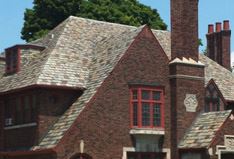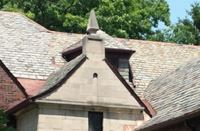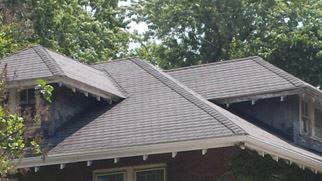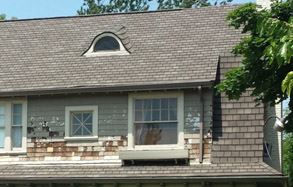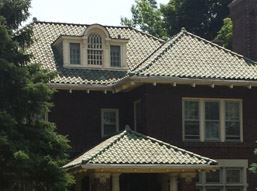REPAIR & REPLACEMENT OF HISTORIC ROOFS
The most frequent problem is that a roof leaks. Owners dread leaks, because water getting into a house can cause collateral damage.
From an historical perspective, however, roofs are not just the roofing material.Roofs include structural features such as dormers, chimneys, and cupolas.
On most houses the roofs are a major component of their architectural character.
If a component of a roof is a character defining feature of a historic building, it should be repaired and preserved, if at all possible. This standard for repair and preservation of historic roofs is from the Secretary of Interior's (SOI) Standards for Rehabilitation of Historic Roofs. For repairing structural and other roof components, see below.
The main thing is to know about roofs and roofing, or to learn.
Repair & Replacement of Roofing Material
While a roof leak is a dreaded event, but it does not necessarily call for replacing all the roofing. Repair may be able to stop the leak. Repair is expected for historically significant roofing material, such as slate or clay tile.
First, stop the leak. A temporarily patch to stop any further water damage to the building is essential (and saves money in the long run.) This also gives time to plan a permanent solution.
Roofs Can Be Repaired
Roofing doesn't fail all at once. Leaks are localized. Therefore, leaks can be repaired without replacing an entire roof. The cost of repair can be far less than replacement. The roofing may be years from needing to be replaced, even though there is a local leak. Then, repair saves money and delays the cost of replacement into the future.
A roof is a system. The roofing material, flashings, gutters, and downspouts work together to shed water. Flashings are the weakest point in any roof system and are the most likely source of leaks. This web site looks at several different kinds of roofs and parts of the roofing system and shows how repairs are made: see How To Repair a Leaky Roof.
Asphalt, slate, and clay tile are repaired in different ways. These are the three most common types of roofing material on historic homes. The section of Specific Roofing Materials (below) discusses repair of each type of roof system.
Roof Replacement
Even the most durable roofing material wears out and must be replaced. The historical standards recognize that replacement eventually is necessary. In the historical standards, the recommendation is to replace a historic roof in kind.
- Slate with slate
- Clay tile with clay tile
- Asphalt with asphalt
However, if using the same kind of material is not technically or economically feasible, then a compatible substitute material may be considered. The SOI Standards for Rehabilitation of Historic Roofs recognize these circumstances.
Most homeowners will not make roof repairs themselves. Even so, knowing about roofs and how to repair them is helpful in dealing with roofing contractors. Contractors like to replace roofs. Knowing that repairs are possible can avoid unnecessary and costly replacement.
Specific Roofing Materials
Asphalt
An asphalt roof on an historic home is not likely to be original. Therefore, repairing it for historic preservation is not likely to be an issue. Repair still may save money.
In particular instances, an original asphalt roof might have been distinctive. If a replacement roof has duplicated it, then continuing to do so would preserve the historic character of the house.
Likewise, some original roofs on historic homes were asphalt. In those cases, the historical standards would expect an asphalt replacement roof, and not something else.
Slate
National Park Service Preservation Brief 29
The slate roofs on the houses in the photos below are one of the principal features that define architectural character. The purpose of Preservation Brief 29 is "to assist... in understanding the causes of slate roof failures and undertaking the repair and replacement of slate roofs.
|
|
Preservation Brief 29 The Repair, Replacement and Maintenance of Historic Slate Roofs is available online, or as a download.
Repair is PossibleIf a slate roof begins to leak, the slates themselves have not necessarily failed.
- Gutters, roof valleys, and flashing at joints are more likely to have failed than the slate itself.
- Metal flashings often wear out before the slate does.
- Ferrous metal fasteners that hold the slate may be corroding, while the slates are still in good condition. This is likely if many slates are sliding out of position.
Because slate has such a long life, slate roofs can be repaired. When flashings and fasteners fail, the slate can be salvaged and, after the repairs, re-laid on the roof.
Installed properly, slate roofs require relatively little maintenance and will last 60 to 125 years or longer depending on the type of slate employed, roof configuration, and the geographical location of the property.
Slate roof repair is viable for localized problems and damaged roofs, as long as the slate have reasonably long serviceable lives remaining.
Broken, cracked, and missing slates should be repaired promptly by an experienced slater.
Often the deterioration of the slate is not uniform. It may be that only one slope of the roof needs replacement and the other slopes can be repaired. In this way, the cost of replacement can be spread over many years.
Replacement of Slate RoofingSlate does deteriorate and eventually wears out.
If 20% or more of the slates on a roof or roof slope are broken, cracked, missing, or sliding out of position, it is usually less expensive to replace the roof (or that slope of the roof) than to execute individual repairs. This is especially true of older roofs nearing the end of their serviceable lives, because even the most experienced slater will likely damage additional slates while attempting repairs.
The historic standard is that a slate roof would be replaced by a new slate roof to preserve the historic character of the building. In many cases, the owner of a building can take a long-term view and see that slate actually can be an economical roofing material, because it will outlast several roofs of a less durable material, such as asphalt roofing.
However, if replacing a slate roof is economically not possible, then the historic standards allow for a substitute roofing material to be used.
There are several alternative roofing materials that can be used when slate is not replaced: James C. Massey, Slate Roof Stand-Ins. A buyer's guide to man-made substitutes for natural stone. However, the man-made substitutes for slate are not entirely satisfactory in appearance or durability.
Often, economics requires replacement with asphalt shingles. Even if asphalt shingles must be used, there are varieties that are more appropriate to replace slate.
Architectural or laminated shingles have two or more layers of roofing material. These have a textural effect with softer lines and deeper shadows than simple shingles. Some laminated shingles emulate the appearance, if not the actual form of slate roofing, with appropriate colors and shadow lines. None of the asphalt slate-like shingles are perfect imitations of slate, of course.
These products also may be thicker and therefore longer lasting than simple shingles.
The photos below show slate-looking asphalt replacement shingles.
|
|
Clay Tile
In the photos beolw, the tile roofs are highly distinctive features of the houses, and they are a major feature defining their architectural character.
The photos below show slate-looking asphalt replacement shingles.
|
|
Preservation Brief 30 has "general guidance … on how to plan and carry out a project involving the repair and selected replacement of historic clay roofing tiles."
Preservation Brief 30 The Preservation and Repair of Historic Clay Tile Roofs is available online, or as a download.
Repair is PossibleClay tiles can be very long-lived. Roof tiles often outlast the structure of a building. Clay tile roofs are complicated systems of clay tiles, fastening or hanging methods, and metal flashing, valleys, and gutters.
National Park Service Preservation Brief 30
A clay tile roof system most commonly fails due to the breakdown of the fastening system and not the tiles themselves. Clay roofing tiles frequently outlast their fastening systems. When a fastening system fails, it will be necessary to remove all of the clay tiles and relay them with new fasteners. If failure is just on the most exposed slope of the roof, then only that portion would need to be removed and re-laid. With the clay tiles removed, any damage to the underlayment can be repaired, and new layers of roof felting can be applied.
Leaks can come from the deterioration of metal flashing, valleys, and gutters. But these failures are not failures of the tile or of the roof system, and they are not reasons to replace the tile roof.
Broken or loose tiles can be re-secured or replaced. Working on tiles without breaking them requires precautions.
Replacement tiles should match the other existing tiles. As one source, original tiles can be salvaged from such places as the rear roof slope of a garage or the house itself. Replacement tiles in those locations are less visible.
Big Mistake! Replacing individual tiles, or large sections of tiles, with any materials other than matching natural clay tiles will sacrifice some of the character of a historic building.
Replacement of Clay Tile RoofingThe historic standard is that a clay tile roof would be repaired, because it is distinctive and long-lasting. Where tiles must be replaced, matching tiles would keep the historic integrity of the roof and the building.
However, if more than about 30 per cent of the roofing tiles are lost, broken, or irreparably damaged, it may be necessary to replace all of the historic tiles with new matching tiles. In such a case, the historic standard is to replace the original clay tile roof with a new clay tile roof of matching character. The owner of a building can take a long-term view and see that clay tiles actually can be an economical roofing material, because it will outlast several roofs of a less durable material, such as asphalt roofing.
However, if replacing a clay tile roof in kind is economically not possible, then the historic standards allow for a substitute roofing material to be used. (See James C. Massey, Slate Roof Stand-Ins. A buyer's guide to man-made substitutes for natural stone.)
Repair & Replacement of Roof Components
Since structural features do not wear out as roofing material does, it is essential to the historic preservation of a building to repair and restore these original features.
Mostly these are issues of carpentry, as well as window repair and restoration. For window repair, see Historic Window Repair and Rehabilitation.

